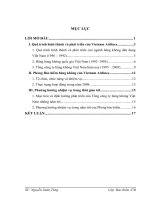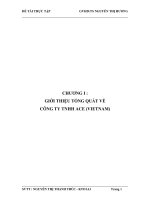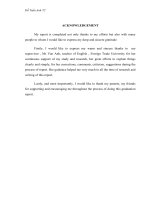Vietnam suplementary
Bạn đang xem bản rút gọn của tài liệu. Xem và tải ngay bản đầy đủ của tài liệu tại đây (347.44 KB, 8 trang )
Reactive Systems
Supplementary on
Rates of Reactions,
Differential and Integrated
Rate Laws
First-order reactions
For first-order reactions:
AB
The time rate of change of the concentration of A, (given by [A]) is:
d[𝐴]
d[𝐵]
= −𝑘 𝐴 =
d𝑡
d𝑡
Differential rate law,
describing rates
∞
Rearrangement of this equation yields:
0
𝐴
ln
𝐴
𝑡
0
= −𝑘𝑡
d[𝐴]
=−
𝐴
𝐴 𝑡 = 𝐴 0𝑒 −𝑘𝑡
Integral rate law, describing concentrations
∞
𝑘𝑑𝑡
0
First-order reactions
Plots the [A(t)]/[A(0)] in the upper panel and the natural log of [A(t)]/[A(0)] in the lower
panel as a function of time for a first-order reaction. Note that the slope of the line in the
lower panel is -k and that the concentration falls to 1/e of its initial value after a time =1/k, often called the lifetime of the reactant. A related quantity is the time it takes for
the concentration to fall to half of its value, obtained from:
𝐴 (𝑡 = 𝜏1/2 ) 1
= = exp(−𝜏1/2 )
[A]0
2
𝜏1/2
ln(2)
=
𝑘
The quantity 1/2 is known as the
half-life of the reactant.
Pseudo first-order reactions
For pseudo first-order reactions:
A + B products
The time rate of change of the concentration of A, (given by [A]) is:
d[𝐴]
= −𝑘 𝐴 [𝐵]
d𝑡
If [B] remains constant (by either
setting [B]0 >> [A]0 or recycling B):
∞
Rearrangement yields:
𝐴
ln
𝐴
0
𝑡
0
= −𝑘 𝐵 0𝑡
𝐴 𝑡 = 𝐴 0𝑒 −𝑘 𝐵 0𝑡
d[𝐴]
=−
𝐴
∞
0
𝑘 𝐵 0𝑑𝑡
Opposing reactions, equilibrium
For pseudo first-order reactions:
A⇋B
The time rate of change of the concentration of A, (given by [A]) is:
d[𝐴]
d[𝐵]
=−
− 𝑘1 𝐴 + 𝑘−1 𝐵
d𝑡
d𝑡
Defining the equilibria as:
and
[𝐴]𝑒 = [𝐴]0 −𝑥𝑒
[𝐵]𝑒 = [𝐵]0 +𝑥𝑒
𝐴 𝑡 = 𝐴 0 + 𝑥𝑒 𝑒 −(𝑘1+𝑘−1)𝑡
This defines the characteristic time for
a system to reach equilibrium. It is
dominated by the largest rate constant.
Parallel reactions
For parallel reactions:
A C (k1)
and
B D (k2)
Consecutive reactions and steadystate approximation
For consecutive reactions:
A B (k1)
and
B C (k2)
Consecutive reactions and steadystate approximation
For parallel reactions:
A C (k1)
For k1 = 10k2
and
B D (k2)
For k2 = 10k1







